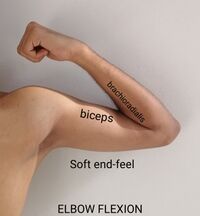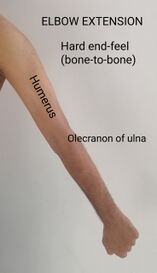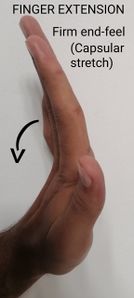End-Feel: Difference between revisions
Anas Mohamed (talk | contribs) No edit summary |
Ahmed M Diab (talk | contribs) No edit summary |
||
| (28 intermediate revisions by 6 users not shown) | |||
| Line 1: | Line 1: | ||
<div class="editorbox"> | <div class="editorbox"> | ||
''' | '''Original Editor '''- [[User:Anas Mohamed|Anas Mohamed]] '' | ||
'Top Contributors''' - {{Special:Contributors/{{FULLPAGENAME}}}}</div> | |||
== | == '''Introduction''' == | ||
[[File:Elbow flextion end-feel.jpg|thumb|'''Normal soft end-feel'''|alt=|216x216px]]"End Feel" is a type of sensation or feeling that the examiner experienced when the [[Joint Classification|joint]] is at the end of its available passive [[Range of Motion|range of motion]] in assessment. There are multiple types of joint end-feels all of which are different for each individual. | |||
* The end of each motion at each joint is limited from further movement by particular anatomical structures. | |||
* The type of structure that limits a joint has a characteristic feel, which may be detected by the therapist performing the passive ROM. | |||
* This feeling, which is experienced by the therapist, as resistance or a barrier to further motion, is called the end-feel<ref name=":0">Susan B.O'Sullivan, Thomas J. Schmitz, George D. Fulk. Physical Rehabilitation. 6th edition. F. A. Davis Company. 2014.</ref> | |||
==== | == Normal End Feel == | ||
[[File:Elbow extension.jpg|thumb|274x274px|'''Normal hard end-feel'''|alt=]]Normal end feel is when the joint has full ROM and the range is stopped by the anatomy of the joint. | |||
3 Classic Normal End Feels | |||
# Bony End Feel (bone to bone): this is a hard, unyielding, abrupt sensation that is painless. eg [[elbow]] extension. | |||
# Soft Tissue Approximation: full range of motion is restricted by the normal muscular bulk, feeling of soft compression, and is painless. Tissue meets tissue. eg flexion of the elbow, by [[Biceps Brachii|biceps]]. | |||
# Tissue [[Stretching|Stretch]]: there is a firm, springy type of movement with a slight give towards the end of the range of motion, normal elastic resistance that is felt when stretching soft tissue. eg lateral flexion of the [[Cervical Anatomy|cervical]] spine<ref name=":2" /> | |||
{| class="wikitable sortable" | {| class="wikitable sortable" | ||
|+'''Normal | |+'''Table.1 Normal End Feel''' <ref name=":0" /> | ||
!End-Feel | !End-Feel | ||
!Structure | !Structure | ||
| Line 36: | Line 30: | ||
|Knee flexion (contact between soft tissue of posterior leg and posterior thigh) | |Knee flexion (contact between soft tissue of posterior leg and posterior thigh) | ||
|- | |- | ||
|Firm | | rowspan="3" |Firm | ||
|Muscular | |Muscular Stretch | ||
|Hip flexion with the knee straight (passive elastic tension of hamstring muscles | |Hip flexion with the knee straight (passive elastic tension of hamstring muscles | ||
|- | |- | ||
|Capsular Stretch | |||
|Capsular | |||
|Extension of metacarpophalangeal joints of fingers (tension in the anterior | |Extension of metacarpophalangeal joints of fingers (tension in the anterior | ||
capsule) | capsule) | ||
|- | |- | ||
|Ligamentous Stretch | |||
|Ligamentous | |||
|Forearm supination (tension in the palmar radioulnar ligament of the inferior | |Forearm supination (tension in the palmar radioulnar ligament of the inferior | ||
radioulnar joint, interosseous membrane, oblique cord) | radioulnar joint, interosseous membrane, oblique cord) | ||
|- | |- | ||
|Hard | |Hard | ||
|Bone | |Bone Contacting Bone | ||
|Elbow extension (contact between the olecranon process of the ulna and the | |Elbow extension (contact between the olecranon process of the ulna and the | ||
| Line 57: | Line 49: | ||
|} | |} | ||
== Abnormal End Feel == | |||
Abnormal End Feel is when the range of the joint is less or greater than normal and is painful, or when a structure other than the normal anatomy of the joint stops the motion | |||
6 Classic Abnormal End Feels | |||
# Bone to Bone (Bony) End Feel: occurs when one would not expect to find a bone to bone end feel, hard, unyielding end feel. Restriction occurs before the normal end of range movement caused by [[Osteophyte|osteophytes]], [[Arthritis|degenerative joint disease]], mal-union of joint following a [[fracture]] etc. | |||
#[[Muscle Cells (Myocyte)|Muscle]] Spasm End Feel: sudden and hard dramatic arrest of movement accompanied by [[Pain Assessment|pain]] which is invoked by the movement. Springy, rebound end feel. Reflexive (protective) muscle guarding designed to prevent further injury. | |||
# Empty End Feel: No physical restriction to the movement but with considerable pain. Maybe full range of motion but with pain. <nowiki>''</nowiki>actually no end feel<nowiki>''</nowiki> Example: acute [[bursitis]], joint inflammation | |||
# Springy Block End Feel (Internal Derangement): springy or rebound sensation in a [[Capsular and Noncapsular Patterns|non-capsular pattern]]. Usually occurs before the end of the normal ROM. eg: loose [[cartilage]], [[Meniscal Lesions|meniscal]] tissue within joints (eg. torn meniscus won’t be able to extend knee fully) | |||
# Leathery End Feel (Capsular Stretch End Feel): similar to tissue stretch but occurs when the ROM is reduced. Hard Capsular – thick quality and the limitation comes on abruptly. Soft Capsular- more often seen with acute conditions, stiffness occurs early in the range, increasing until the end of the range is reached. | |||
# Boggy or Soft End Feel: occurs if you have a joint [[Effusion tests|effusion]] or [[Oedema Assessment|edema]], mushy with soft quality to it -may indicate acute [[Inflammation Acute and Chronic|inflammation]]. eg acute moderate to severe [[Ligament Sprain|sprain]], [[Ligament Sprain|ligamentous injury]]<ref name=":2">Medical Massage Therapy [https://www.massagetherapyreference.com/rom-end-feel/ ROM End Feel] Available: https://www.massagetherapyreference.com/rom-end-feel/ (accessed 27.10.2021)</ref> | |||
{| class="wikitable sortable" | {| class="wikitable sortable" | ||
|+Examples<ref name=":0" /> | |+Table.2 Abnormal End Feel Examples<ref name=":0" /> | ||
!End | !End Feel | ||
!Examples | !Examples | ||
|- | |- | ||
|Soft | |Soft | ||
|Soft | |Soft Tissue Edema | ||
Synovitis | Synovitis | ||
|- | |- | ||
|Firm | |Firm | ||
|Increased | |Increased Muscle Tone | ||
Capsular, | Capsular, Muscular, or Ligamentous Shortening | ||
|- | |- | ||
|Hard | |Hard | ||
| Line 84: | Line 78: | ||
Osteoarthritis | Osteoarthritis | ||
Myositis | Myositis Ossificans | ||
Fracture | Fracture | ||
Loose | Loose Bodies in Joint | ||
|- | |- | ||
|Empty | |Empty | ||
|Acute | |Acute Joint Inflammation | ||
Bursitis | Bursitis | ||
| Line 99: | Line 93: | ||
Fracture | Fracture | ||
Psychogenic | Psychogenic Disorder | ||
|} | |} | ||
== Significance == | |||
[[File:Wrist extension.jpg|thumb|300x300px|'''Normal firm end -feel'''|alt=]]An appropriate assessment of end feel can support the examiner | |||
* To assess the type of pathology present<ref name=":1">David J. Magee. Orthopedic Physical Assessment. 6th edition. Elsevier. 2014.</ref> | |||
* To identify the limiting structures and choose a focused and effective treatment<ref name=":1" /> | |||
* Determine a prognosis for the condition<ref name=":1" /> | |||
* Learn the severity or stage of the problem<ref name=":1" /> | |||
<br> | |||
By determining if the pain or restriction is the main problem, the examiner can determine if a more gentle treatment should be given (pain predominating) or a more vigorous treatment (restriction predominantly).<ref name=":1" /> | |||
== Examination == | == Examination == | ||
Building up the capacity to decide the kind of end feel takes practice and sensitivity. | |||
* When assessing passive movement, the examiner should apply overpressure at the end of the ROM to determine the quality of end feel ( the sensation the examiner "feels" in the joint as it reaches the end of the ROM ) of each passive movement.<ref name=":1" /> | * When assessing passive movement, the examiner should apply overpressure at the end of the ROM to determine the quality of end feel ( the sensation the examiner "feels" in the joint as it reaches the end of the ROM ) of each passive movement.<ref name=":1" /> | ||
* Passive ROM, particularly towards the end of the motion, must be performed slowly and carefully when testing end feel.<ref name=":0" /> | * Passive ROM, particularly towards the end of the motion, must be performed slowly and carefully when testing end feel.<ref name=":0" /> | ||
* Secure stabilization of the bone proximal to the joint being tested is critical in preventing multiple joints and structure from moving and interfering with the determination of the end feel<ref name=":0" /> | * Secure stabilization of the bone proximal to the joint being tested is critical in preventing multiple joints and structure from moving and interfering with the determination of the end feel<ref name=":0" /> | ||
* To be sure that severe symptoms are not provoked. If the patient is able to hold a position at the end of the physiological ROM (end range of active movement) without provoking symptoms or if the symptoms ease quickly after returning to the resting position, then the end feel can be tested. Pain with pathological end feel is common ( if the patient has severe pain at the end range, end feel should only be tested with extreme care).<ref name=":1" /> | * To be sure that severe symptoms are not provoked. If the patient is able to hold a position at the end of the physiological ROM (end range of active movement) without provoking symptoms or if the symptoms ease quickly after returning to the resting position, then the end feel can be tested. Pain with pathological end feel is common ( if the patient has severe pain at the end range, end feel should only be tested with extreme care).<ref name=":1" /> | ||
{| width="100%" cellspacing="1" cellpadding="1" | {| width="100%" cellspacing="1" cellpadding="1" | ||
|- | |- | ||
|{{#ev:youtube| | |{{#ev:youtube|p8E_ksL96HI|300}} <ref>Clinical Physio.Shoulder Passive Range of Movement Testing | Clinical Physio Premium. Available from: https://youtu.be/p8E_ksL96HI </ref> | ||
|{{#ev:youtube| | |{{#ev:youtube|1vdUakzxujI|300}} <ref>Dominican College.Assessment of knee flexion end feel. Available from: https://youtu.be/1vdUakzxujI </ref> | ||
https://youtu.be/ | |{{#ev:youtube|LlgwDmqBqlQ|300}} <ref>Dominican College. Assessing ankle DF and elbow ext end feel. Available from: https://youtu.be/LlgwDmqBqlQ </ref> | ||
|} | |} | ||
== References == | == References == | ||
<references group="t78t7f7frfyf" /> | <references group="t78t7f7frfyf" /> | ||
<references /> | <references /> | ||
[[Category:Assessment]] | |||
[[Category:Joints]] | |||
Latest revision as of 14:28, 3 February 2024
Original Editor - Anas Mohamed
'Top Contributors - Anas Mohamed, Naomi O'Reilly, Lucinda hampton, Kim Jackson, Ahmed M Diab and Shaimaa EldibIntroduction[edit | edit source]
"End Feel" is a type of sensation or feeling that the examiner experienced when the joint is at the end of its available passive range of motion in assessment. There are multiple types of joint end-feels all of which are different for each individual.
- The end of each motion at each joint is limited from further movement by particular anatomical structures.
- The type of structure that limits a joint has a characteristic feel, which may be detected by the therapist performing the passive ROM.
- This feeling, which is experienced by the therapist, as resistance or a barrier to further motion, is called the end-feel[1]
Normal End Feel[edit | edit source]
Normal end feel is when the joint has full ROM and the range is stopped by the anatomy of the joint.
3 Classic Normal End Feels
- Bony End Feel (bone to bone): this is a hard, unyielding, abrupt sensation that is painless. eg elbow extension.
- Soft Tissue Approximation: full range of motion is restricted by the normal muscular bulk, feeling of soft compression, and is painless. Tissue meets tissue. eg flexion of the elbow, by biceps.
- Tissue Stretch: there is a firm, springy type of movement with a slight give towards the end of the range of motion, normal elastic resistance that is felt when stretching soft tissue. eg lateral flexion of the cervical spine[2]
| End-Feel | Structure | Examples |
|---|---|---|
| Soft | Soft tissue approximation | Knee flexion (contact between soft tissue of posterior leg and posterior thigh) |
| Firm | Muscular Stretch | Hip flexion with the knee straight (passive elastic tension of hamstring muscles |
| Capsular Stretch | Extension of metacarpophalangeal joints of fingers (tension in the anterior
capsule) | |
| Ligamentous Stretch | Forearm supination (tension in the palmar radioulnar ligament of the inferior
radioulnar joint, interosseous membrane, oblique cord) | |
| Hard | Bone Contacting Bone | Elbow extension (contact between the olecranon process of the ulna and the
olecranon fossa of the humerus |
Abnormal End Feel[edit | edit source]
Abnormal End Feel is when the range of the joint is less or greater than normal and is painful, or when a structure other than the normal anatomy of the joint stops the motion
6 Classic Abnormal End Feels
- Bone to Bone (Bony) End Feel: occurs when one would not expect to find a bone to bone end feel, hard, unyielding end feel. Restriction occurs before the normal end of range movement caused by osteophytes, degenerative joint disease, mal-union of joint following a fracture etc.
- Muscle Spasm End Feel: sudden and hard dramatic arrest of movement accompanied by pain which is invoked by the movement. Springy, rebound end feel. Reflexive (protective) muscle guarding designed to prevent further injury.
- Empty End Feel: No physical restriction to the movement but with considerable pain. Maybe full range of motion but with pain. ''actually no end feel'' Example: acute bursitis, joint inflammation
- Springy Block End Feel (Internal Derangement): springy or rebound sensation in a non-capsular pattern. Usually occurs before the end of the normal ROM. eg: loose cartilage, meniscal tissue within joints (eg. torn meniscus won’t be able to extend knee fully)
- Leathery End Feel (Capsular Stretch End Feel): similar to tissue stretch but occurs when the ROM is reduced. Hard Capsular – thick quality and the limitation comes on abruptly. Soft Capsular- more often seen with acute conditions, stiffness occurs early in the range, increasing until the end of the range is reached.
- Boggy or Soft End Feel: occurs if you have a joint effusion or edema, mushy with soft quality to it -may indicate acute inflammation. eg acute moderate to severe sprain, ligamentous injury[2]
| End Feel | Examples |
|---|---|
| Soft | Soft Tissue Edema
Synovitis |
| Firm | Increased Muscle Tone
Capsular, Muscular, or Ligamentous Shortening |
| Hard | Chondromalacia
Osteoarthritis Myositis Ossificans Fracture Loose Bodies in Joint |
| Empty | Acute Joint Inflammation
Bursitis Abscess Fracture Psychogenic Disorder |
Significance[edit | edit source]
An appropriate assessment of end feel can support the examiner
- To assess the type of pathology present[3]
- To identify the limiting structures and choose a focused and effective treatment[3]
- Determine a prognosis for the condition[3]
- Learn the severity or stage of the problem[3]
By determining if the pain or restriction is the main problem, the examiner can determine if a more gentle treatment should be given (pain predominating) or a more vigorous treatment (restriction predominantly).[3]
Examination[edit | edit source]
Building up the capacity to decide the kind of end feel takes practice and sensitivity.
- When assessing passive movement, the examiner should apply overpressure at the end of the ROM to determine the quality of end feel ( the sensation the examiner "feels" in the joint as it reaches the end of the ROM ) of each passive movement.[3]
- Passive ROM, particularly towards the end of the motion, must be performed slowly and carefully when testing end feel.[1]
- Secure stabilization of the bone proximal to the joint being tested is critical in preventing multiple joints and structure from moving and interfering with the determination of the end feel[1]
- To be sure that severe symptoms are not provoked. If the patient is able to hold a position at the end of the physiological ROM (end range of active movement) without provoking symptoms or if the symptoms ease quickly after returning to the resting position, then the end feel can be tested. Pain with pathological end feel is common ( if the patient has severe pain at the end range, end feel should only be tested with extreme care).[3]
| [4] | [5] | [6] |
References[edit | edit source]
- ↑ 1.0 1.1 1.2 1.3 1.4 Susan B.O'Sullivan, Thomas J. Schmitz, George D. Fulk. Physical Rehabilitation. 6th edition. F. A. Davis Company. 2014.
- ↑ 2.0 2.1 Medical Massage Therapy ROM End Feel Available: https://www.massagetherapyreference.com/rom-end-feel/ (accessed 27.10.2021)
- ↑ 3.0 3.1 3.2 3.3 3.4 3.5 3.6 David J. Magee. Orthopedic Physical Assessment. 6th edition. Elsevier. 2014.
- ↑ Clinical Physio.Shoulder Passive Range of Movement Testing | Clinical Physio Premium. Available from: https://youtu.be/p8E_ksL96HI
- ↑ Dominican College.Assessment of knee flexion end feel. Available from: https://youtu.be/1vdUakzxujI
- ↑ Dominican College. Assessing ankle DF and elbow ext end feel. Available from: https://youtu.be/LlgwDmqBqlQ









